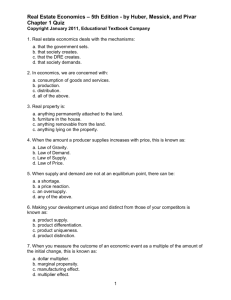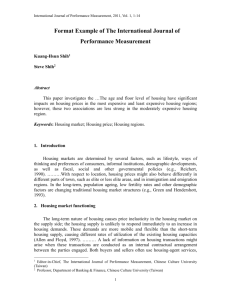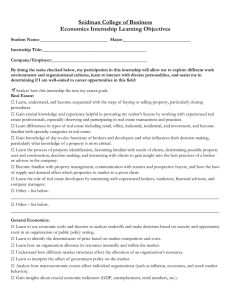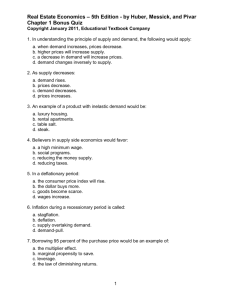A Scholarly Appreciation of Peter Linneman
advertisement
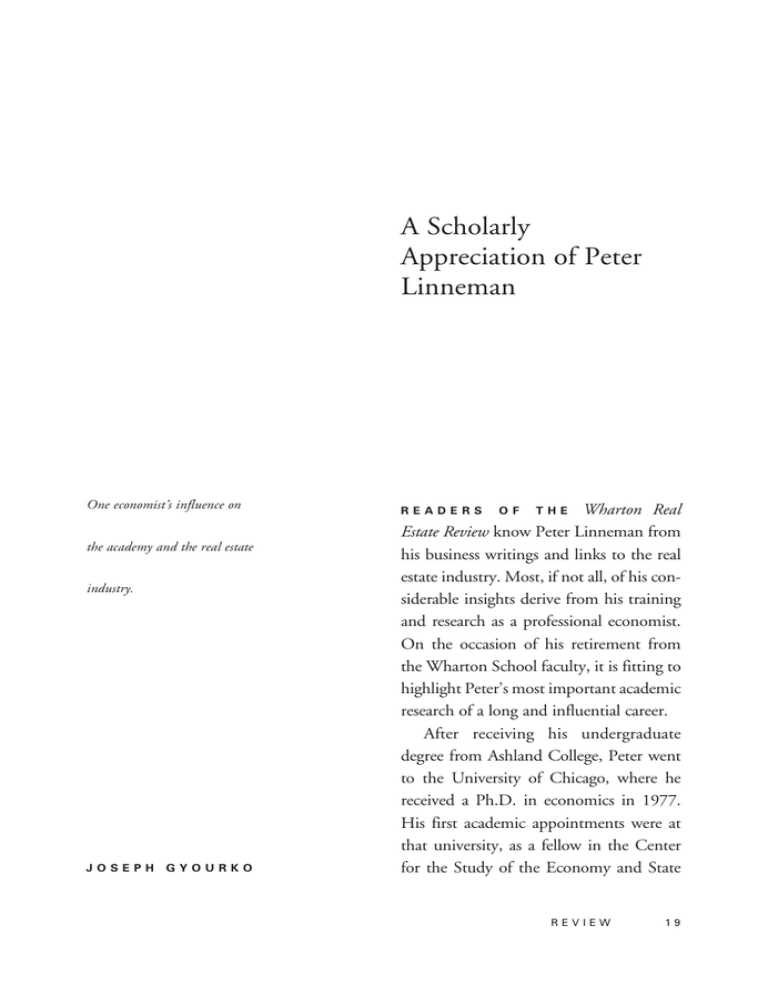
A Scholarly Appreciation of Peter Linneman One economist’s influence on the academy and the real estate industry. JOSEPH GYOURKO R E A D E R S O F T H E Wharton Real Estate Review know Peter Linneman from his business writings and links to the real estate industry. Most, if not all, of his considerable insights derive from his training and research as a professional economist. On the occasion of his retirement from the Wharton School faculty, it is fitting to highlight Peter’s most important academic research of a long and influential career. After receiving his undergraduate degree from Ashland College, Peter went to the University of Chicago, where he received a Ph.D. in economics in 1977. His first academic appointments were at that university, as a fellow in the Center for the Study of the Economy and State REVIEW 19 from 1977 to 1979, and then as assistant professor in the graduate school of business (now the Booth School), from 1978 to 1979. He joined Wharton’s Finance Department the following year, and remained at Wharton thereafter. Peter’s move into real estate began in 1985 when he became the director of what was then the Wharton Real Estate Center. He served as director for a dozen years, stepping down in 1997 just after it was renamed the Samuel Zell and Robert Lurie Real Estate Center following Sam Zell’s major endowment gift. Equally important, in 1990 he became the first chair of the newly formed Real Estate Department, in which capacity he served for the next seven years. He played a key role in establishing the real estate program, with standing faculty and a curriculum on par with any department in the school. Wharton remains the only top business school to have established a distinct real estate group with a major in the regular curriculum designed to train future leaders of the industry. Leaders of academic programs, newly formed risky ones in particular, are usually accomplished scholars in their own right. That certainly is true of Peter Linneman. His first influential research was on a topic of great interest to both housing and urban economists: the value of housing traits. In the housing market, we observe trades of individual housing units, but are often 20 interested in what traits or attributes, such as extra bedrooms or larger kitchens, made the units valuable. However, the problem is that there is no market or exchange on which bedrooms and kitchens are traded. To get around this problem, economists have come up with an ingenious way of identifying the value of a bedroom by observing the overall prices of different homes using a technique called hedonic regression, with the estimated price of a bedroom being implicit because there is no explicit price observed. Peter, a pioneer in the use of this technique, published some of the first work on the subject in the Journal of Urban Economics in 1980 and 1981, making it part of the standard tool kit of all economists (Table I). All the estimates one sees about the market value of redoing a kitchen are based on this path-breaking research, so the work was influential beyond the academy. It will not surprise anyone who knows Peter that his research was not focused on just one topic. His interests have always been eclectic. The influence of one of his academic mentors, the late Nobel laureate in economics George Stigler, is evident in a series of writings on the impact of regulation. Peter’s study of the winners and losers from imposing a minimum wage remains a classic. He also published influential papers on the impact of consumer safety standards in the Journal of Law and Economics, and on the role of unions. ZELL/LURIE REAL ESTATE CENTER Table I: Selected articles of Peter Linneman “Some Evidence on the Functional Form of the Hedonic Price Function for the Urban Housing Market,” Journal of Urban Economics, Vol. 8, No. 1, July 1980. 47-68. “A Case Study of the Impacts of Consumer Safety Standards: The 1973 Mattress Flammability Standard,” Journal of Law and Economics, Vol. 23, No. 2, October 1980. 461-79. “The Demand for Residence Site Characteristics,” Journal of Urban Economics, Vol. 9, No. 2, March 1981. 129-48. “The Economic Impacts of Minimum Wage Laws: A New Look at an Old Question,” Journal of Political Economy, Vol. 90, No. 3, June 1982. 443-69. “An Economic Analysis of the Homeownership Decision,” Journal of Urban Economics, Vol. 17, No. 2, March 1985. 230-46. “Rising Union Premiums and Declining Boundaries Among Noncompeting Groups,” co-authored with Michael Wachter, American Economic Review, Vol. 76, No. 2, May 1986. 103-108. “An Empirical Test of the Efficiency of the Housing Market,” Journal of Urban Economics, Vol. 20, No. 2, September 1986. 140-54. “An Empirical Evaluation of the Distributional Effects of Rent Controls: The Case of New York City,” Journal of Urban Economics, Vol. 22, No. 1, January 1987. 14-37. “An Empirical Analysis of the Equity and Efficiency of Rent Controls,” Journal of Urban Economics, co-authored with Joseph Gyourko, Vol. 26, No. 1, July 1989. 54-74. “The Impacts of Borrowing Constraints on Homeownership,” The Journal of the American Real Estate and Urban Economics Association, co-authored with Susan Wachter, Vol. 17, No. 4, 1992. 389-402. “Affordability of the American Dream: An Examination of the Last 30 Years,” Journal of Housing Research, co-authored with Joseph Gyourko, Vol. 4, No. 1, 1993. 39-72. “The Changing Influences of Education, Income, Family Structure, and Race on Homeownership by Age Over Time,” Journal of Housing Research, co-authored with Joseph Gyourko, Vol. 8, No. 1, 1997. 1-26. REVIEW 21 Peter’s interest in the economics of regulation soon expanded into the real estate sector in a series of papers on rent control. I was fortunate enough to be a co-author on some of these, which include the first estimates of how New York City’s rent controls lowered housing quality as landlords effectively reduced their capital investment in the face of a mandated price ceiling on their assets. In 1980s, he focused on real estate as a research topic. His longest-running and most influential research program is on the subject of housing. There are a number of firsts in this body of work. He performed the first formal test of the efficiency of the owneroccupied housing market, concluding that while one could predict what homes would sell for based on their location and traits, there were no arbitrage profits because of the very high transactions costs involved in buying and selling homes. He was also one of the early researchers into the economics of the decision to rent or own, and his 1985 Journal of Urban Economics paper remains a classic on this topic. Housing affordability has been a longrun interest, too. Peter and I wrote an analysis of affordability conditions over the previous three decades that appeared in 1993 in the Journal of Housing Research. Other work in this area includes important studies on the role of wealth differences and the large racial gaps in homeownership rates. One of the most influential 22 studies ever written in this area is Peter’s 1992 paper with our colleague Susan Wachter on the relative importance of income versus down payment constraints in determining why people do not own. This work showed for the first time that the wealth and savings shortfalls that limited the ability to amass a down payment were more influential than payment-toincome rules in preventing households from owning. This study quickly became well known in policy circles, and served as the intellectual underpinning of subsequent efforts to help poorer households with down payments. While carrying out research and leading the Wharton real estate program, Peter wrote Real Estate Finance & Investments: Risks and Opportunities, which has become an important and high-quality textbook on real estate finance. He ably places the structure of real estate finance within the broader field of finance, particularly as it relates to property pricing and the capital structure of firms and deals. Not only is this now the standard text in Wharton’s required real estate finance course, it is used in real estate courses nationwide. In the mid-1990s, Peter turned his efforts to the Wharton Real Estate Review, of which he became a co-editor with Witold Rybczynski. Both have more than ably served in those roles ever since. By my count, Peter has written thirty-five articles for the Review, ranging from early ZELL/LURIE REAL ESTATE CENTER discussions of the rise of the public equity markets as the industry recapitalized following its last major crash, to recent articles on just what went wrong this time. There is no important issue for the industry that he has not addressed in the Review, or encouraged others write about in his role as co-editor. The Review has become our program’s primary link of research with industry practitioners, and Peter and Witold will continue to serve as co-editors. Peter has been a major influence on both the academy and industry. His influence among housing and real estate economists derives from an unerring ability to identify the most relevant and important issues over long periods of time, and then to bring his penetrating economic insights to bear on these times. This body of work served as the foundation for his leadership in creating a new and novel real estate program at one of the world’s great business schools. We now know that both his research and this program have stood the test of time. Many of us at Wharton, and throughout the industry, have been the beneficiaries of his important work, and for it, we owe Peter Linneman much gratitude. REVIEW 23
